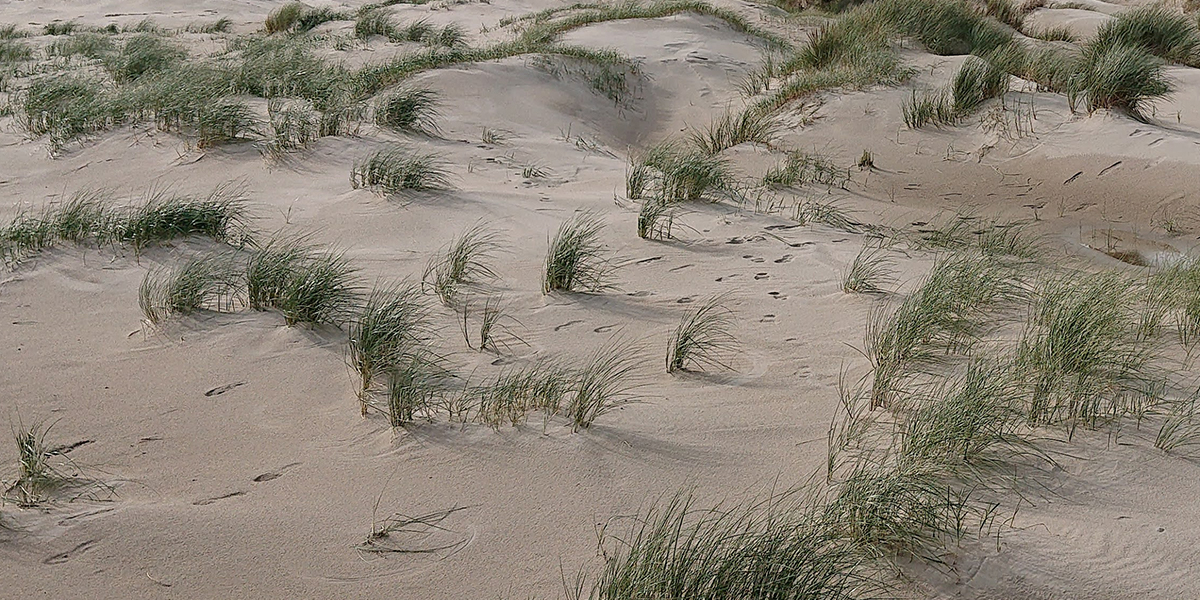Builders on the beach
Coastal ecosystems are under increasing stress from sea-level rise and drought and rapidly declining worldwide. Recent findings reveal that, similar to other stressed ecosystems like drylands, the restoration of coastal ecosystems is only successful when key biophysical feedbacks and spatial processes are targeted. Seagrass and marsh grasses for instance form large patches that generate self-facilitation, and mimicking such patches improves restoration. This approach, however, proved insufficient for dune grasses. We propose to test the hypothesis that dune grasses self-organize to rapidly form high freshwater-storing dunes to survive flooding and drought, hinting towards new trait-based improved restoration designs.
|
|
|
Only a multidisciplinary research team combining its expertise can make progress in restoring ecology and natural coastal defences |
| Angeles Garcia Mayor, Tjisse van der Heide |
Project description
Coastal dunes, salt marshes, and seagrass meadows combined generate a global value of over 5.5 trillion US$/year in ecosystem services (e.g. flood protection, water purification, nutrient cycling, carbon storage, tourism, fisheries, biodiversity). However, these ecosystems are rapidly degrading due to increased human and climatic pressure. Worldwide, 70% of the beaches are eroding, while 50% of salt marshes and 30% of seagrass meadows are now degraded or lost1.
Similar to other stressed ecosystems such as dryland ecosystems2,3, mounting evidence highlights that the establishment of coastal plants often hinges on the initiation of key biophysical feedbacks related to particular spatial patterns4,5,6. For instance, recent research showed that the establishment of seagrass and salt marsh grasses doubles if planted in clumps instead of conventional evenly dispersed designs4. The larger plant patches of clumped arrangements allow facilitation processes that trigger reinforcing feedbacks between plants and their local environment. Follow-up work mimicking clumped vegetation patches with biodegradable establishment structures also proved successful and may allow upscaling by limiting donor material and reducing costs5. However, similar planting designs with dune grasses proved insufficient in pilot experiments (unpublished data).

Central hypothesis: Patchy growing dune grasses need to rapidly form high, water-storing dunes beyond a minimum size treshold to survive droughts and floodings, hinting towards new trait-based restoration designs.
Indeed, other recent work revealed that, rather than forming single large vegetation patches, dune grasses adopt a clonal expansion strategy that generates multiple smaller patches instead of one big clump6. Such strategy optimizes sand trapping and thus maximizes dune formation rate. The faster buildup of a higher dune would allow grasses to escape erosion from flooding. Furthermore, grasses in such larger dunes may better cope with freshwater limitation (from both seawater flooding and drought) by having access to rainwater stored as capillary hang water and developing freshwater lenses above the saline groundwater7 (see graphical abstract). Pilot experiments with dune grasses also suggest that a dune-size threshold may be surpassed to trigger these establishing dynamics (unpublished data). In drylands, vegetation self-organizes to form spatial patterns that optimize water storage through increased water infiltration in patches and allow plants to survive drought2,3. Inspired by the parallels with drylands, our new team will join expertise from coastal and dryland ecosystems to explore if dune grasses also organize themselves in spatial patterns that optimize the buildup of freshwater-storing dunes to survive flooding and drought .
Therefore, we here propose to test the overarching hypothesis that dune grasses need to rapidly form embryonic dunes, sized beyond a threshold to establish and survive flooding and drought. We predict that threshold dune sizes exist for two distinct bottlenecks (see graphical abstract). First, we hypothesize that a minimum dune size is required to allow plants to escape physical stress from erosion during flooding events6. A second bottleneck, however, may be a lack of freshwater during drought or flooding, particularly when the root systems of young plants are still immature. We hypothesize that embryonic dunes generated by the patchy patterned grasses provide easily accessible rainwater storage as capillary hang water and small (often transient) freshwater lenses above the saline groundwater7. Hence, as occurs with dryland vegetation, spatial self-organization and associated biophysical feedbacks may also allow dune grasses to survive erosion and drought. Unraveling such key biophysical feedbacks, spatial patterns, and dune-size thresholds underlying establishing dynamics of coastal dunes will allow us to design and test new targeted restoration strategies in a step forward to combating the degradation and loss of this key ecosystem.
References
- Barbier EB, Hacker SD, Kennedy C, Koch EW, Stier AC, Silliman BR (2011) The value of estuarine and coastal ecosystem services. Ecol. Monogr. 81: 169-193.
- Mayor AG, Bautista S, Rodriguez F, Kéfi S (2019) Connectivity-mediated ecohydrological feedbacks and regime shifts in drylands. Ecosystems 22: 1497-1511.
- Berghuis PMJ, Mayor AG, Rietkerk M, Baudena M (2020) More is not necessarily better: The role of cover and spatial organization of resource sinks in the restoration of patchy drylands. J. Arid Environ. 183: 104282.
- Silliman BR, Schrack E, He Q, Cope R, Santoni A, van der Heide T, . . . van de Koppel J (2015) Facilitation shifts paradigms and can amplify coastal restoration efforts. PNAS 112: 14295-14300.
- Temmink RJM, Christianen MJA, Fivash GS, Angelini C, Boström C, Didderen K, . . . van der Heide T (2020) Mimicry of emergent traits amplifies coastal restoration success. Nat. Comm. 11: 3668.
- Reijers VC, Siteur K, Hoeks S, van Belzen J, Borst ACW, Heusinkveld JHT, . . . van der Heide T (2019) A Lévy expansion strategy optimizes early dune building by beach grasses. Nat. Comm. 10: 2656.
- Grootjans A, Stuyfzand P, Everts H, de Vries N, Kooijman A, Oostermeije G, . . . Shahrudin R. Ontwikkeling van zoet-zout gradiënten met en zonder dynamisch kustbeheer. Report No. 2014/OBN193-DK, 119p (VBNE, Driebergen, 2014).

Connected themes
- Our Dynamic Coasts
- Sustainable functioning of Coastal and Shelf Seas


